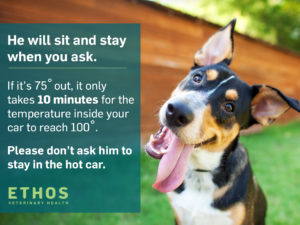6 Steps To Take When You See A Dog In A Hot Car
August 14, 2015Even as we ease closer to Fall and all of its cool breeze, pumpkin spice glory, temperatures can still be hot well into September. There are many reasons why pets and children should never be left unattended in cars; it happens though, and it only takes minutes for the inside temperature to reach a dangerous levels. Below, are a few steps you can take if you find a dog in a parked car on a warm day.

- Know the Facts. Educate yourself on your state and town laws on leaving dogs in cars. Knowing the laws in your area will help you determine the next best step to take.
- If you don’t know your state laws, look them up here: Table of State Laws That Protect Animals.
- Know the Signs. Some may not know the dangers of leaving dogs in a car on hot days. It’s important to educate and spread the word. Heat sickness and stroke can happen quickly. Some symptoms you can see while observing the dog are: excessive panting with dark red gum color, muscle tremors, wobbly balance, or in severe cases, seizures or unconsciousness.
- Gather the Information. Take a look at the scene and take down the car information: plate number, color, make and model. Take a couple of pictures. Are the windows closed? Is the dog in poor condition? This could mean you have to work faster – skip to step 6.
- Locate the Owner. If the dog is stable and windows are down, walk into the store where the car is parked and have the manager page the owner of the car. Everyone is busy, and you probably don’t think you have the time, but heat stroke leads to death very quickly. It will take a minute to walk into a store and page the car’s owner. You’ll be glad you did. Go back to the car after you give the information to the store manager. If the owner comes out, politely remind them how hot the car can get in hot temperatures. Perhaps they did not realize that even in 75 degree weather it can reach extreme temperature inside the car. Spreading the information positively can help more people know the risks.
- Call the authorities. After you have returned to the dog in the car, if the owner has not shown up in a reasonable amount of time, call the local police. Again, stay with the car and the dog until they arrive.
We hope you will not need to use these tips, but if you do come across this situation, we hope this will help you be well informed and prepared.
MA State Law on Animal in Vehicles
NH State Law on Animals in Vehicles
NY State Law on Animals in Vehicles– law 353-d